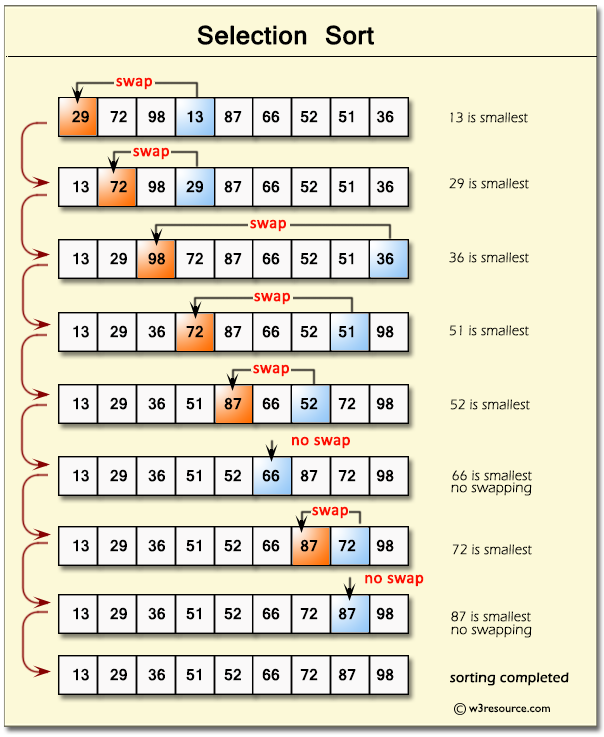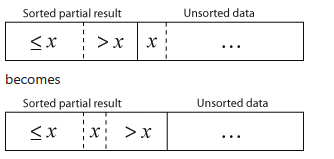Peter Cao
AP Computer Science A 💻
130 resourcesSee Units
7.6: Sorting
The other major application of ArrayLists is sorting, which is placing elements in an ascending or descending order, but it is mainly used for ascending order. There are many sorting algorithms, but we'll only learn selection sort and insertion sort in this unit and merge sort in Unit 10. There are many others that you can view in this video:
🎥 Video on 50+ Sorts, Visualized - Bar Graph *Seize Warning*
Courtesy of Musicombo.
Determining Whether An ArrayList is Sorted
To determine whether an ArrayList is sorted, there is a quick algorithm that sees if the elements are always increasing. Here is its implementation:
/** Returns if the ArrayList is sorted in ascending order
*/
public static boolean isSorted(ArrayList<Integer> array) {
for (int i = 0; i < array.size() - 1) {
if (array.get(i + 1) < array.get(i)) { //checks if two array elements are in the
return false; // wrong order
}
}
return true;
} Selection Sort
Selection sort is the simpler of the two sorting algorithms. The selection sort divides the ArrayList into two "subarrays:" the first being a sorted subarray and the second being the unsorted subarray. Here is the implementation preceded by pseudocode which explains why it's called the selection sort:
/** Uses selection sort on an ArrayList
* 1. Originally the ArrayList is unsorted
* 2. We select the smallest number and swap it with the first element
* 3. Now the sorted subarray is the first item and the rest of the array is unsorted
* 4. Select the smallest of the unsorted numbers (the second smallest overall) and
* swap it with the second element
* 5. Now the first two elements are sorted and the rest are unsorted
* 6. Repeat until the rest of the elements are sorted
*/
public static ArrayList<Integer> selectionSort(ArrayList<Integer> array) {
for (int i = 0; i < array.size() - 1; i++) { // traverse to the second to last item, the last item is automatically the largest
int smallestIndex = i;
int smallestElement = array.get(i);
for (int j = i + 1; i < array.size(); j++) { //traverse through the rest of the array, looking for the smallest remaining item (less than smallestElement)
if (array.get(j) < smallestElement) {
smallestIndex = j;
smallestElement = array.get(j);
}
}
if (smallestIndex > i) { // swap the elements of i and j if the element of i isn't already the smallest
int originalItem = array.get(i);
array.set(i, smallestElement);
array.set(smallestIndex, originalItem);
}
}
return array;
} Here is a visual graphic showing selection sort:

Courtesy of w3resource.
Insertion Sort
The other sorting algorithm is the insertion sort. Like selection sort, there are sorted and unsorted subarrays. Here is the implementation and pseudocode explaining why it is called insertion sort:
/** Uses insertion sort on an ArrayList
* 1. Assume the first element is already sorted
* 2. Select the second element
* 3. Insert it before the first element or keep it in place to make the first 2 elements sorted
* 4. Select the third element and insert it so that the first 3 elements are sorted
* 5. Repeat until all elements are sorted.
*/
public static ArrayList<Integer> insertionSort(ArrayList<Integer> array) {
for (int i = 1; i < array.length(); i++) {
int currentElement = array.get(i);
int currentIndex = i;
for (int j = i; j > 0 ; j--) {
if (currentElement < array.get(j - 1)) { // shifting the item left until properly placed by swapping consecutive items
itemToRight = array.get(j - 1);
array.set(j - 1, currentElement);
array.set(j, itemToRight);
}
}
}
return array;
} Here is a visual version of insertion sort:

Courtesy of Wikipedia.
Browse Study Guides By Unit
➕Unit 1 – Primitive Types
📱Unit 2 – Using Objects
🖥Unit 3 – Boolean Expressions & if Statements
🕹Unit 4 – Iteration
⚙️Unit 5 – Writing Classes
⌚️Unit 6 – Array
💾Unit 7 – ArrayList
💻Unit 8 – 2D Array
🖲Unit 9 – Inheritance
🖱Unit 10 – Recursion
🙏Exam Reviews

Fiveable
Resources
© 2023 Fiveable Inc. All rights reserved.